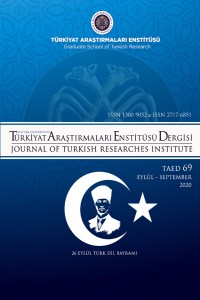Öz
Âdem ile Havva’nın cennette tattıkları yasak ağacın hikâyesi Tevrat ve Kur’an’da çeşitli benzerlik ve farklılıklarla kayıtlıdır. Kur’an’a göre, Âdem ve eşinin yeryüzüne indirilmeleri, Allah’ın yasakladığı ancak şeytanın kandırması sonucu tattıkları bir ağaç (meyvesi) nedeniyledir. Tevrat versiyonunda ise yılan, kadını ayartan olarak takdim edilmiştir. Yılanın kandırdığı kadın bu yasak meyveden hem kendi yemiş hem de erkeğe yedirmiştir. Hikâyenin sonunda yılan, kadın ve erkek cezalandırılmıştır. Tevrat ve Kur’an’daki yasak ağaç hikâyesinin görece yeni bir versiyonu Nil nehrinin kaynağını arama yolunda çeşitli maceralara atılan şehzadenin başından geçen bir olayda işlenmiştir. Anlatıda, Kur’an versiyonuna paralellikler bulunmakla birlikte, her iki eski versiyonda (Tevrat ve Kur’an’da) çıkış noktası olan yaratılış motifi burada yerini esrarengiz bir yolculuğa bırakmıştır. Bu yazıda, Kur’an ve Tevrat’ta kayıtlı “yasak ağaç” hikâyesinin görece yeni bir versiyonu tanıtılacak, söz konusu anlatının bu bağlamda kutsal kitaplarla ilişkileri üzerinde durulacaktır. Böylece arkaik anlatıların günümüze uzanan izlekleri ve anlatılardaki motiflerin sürekliliği ile ilgili bir düşünce biçimi oluşturulmaya çalışılacaktır.
Anahtar Kelimeler
Kaynakça
- Aydar, Hidayet. (2006). “Adem’in Meyvesi”. Meyve Kitabı, (Ed. Emine Gürsoy Naskali, Dilek Herkmen). İstanbul: Kitabevi Yayınları, 83-104.
- Daşdemir, Özkan. (2015). “Alevi-Bektaşi Geleneğinde Elma”. Uluslararası Sosyal Araştırmalar Dergisi, 8/37, 83-97.
- Gürkan, Salime Leyla. (2003). “Yahudi ve İslam Kutsal Metinlerinde İnsan’ın Yaratılışı ve Cennet’ten Düşüş”. İslâm Araştırmaları Dergisi. 9, 1-48.
- Kahraman, Ferruh. (2013). “Bir Tefsîr-Kelâm Problemi: Hz. Âdem’in Yasak Ağaca Yaklaşması”. Sakarya Üniversitesi İlahiyat Fakültesi Dergisi, XV/27, 191-226.
- Mardrus, Joseph Charles. (2012). Binbir Gece Masalları, 1/1, (Çev. Âlim Şerif Onaran). İstanbul: Yapı Kredi Yayınları.
- Y.y. (1626). Süleyman Aleyhisselam Hikâyesi. İstanbul: İstanbul Millet Kütüphanesi, 34Ae Roman 148.
- Y.y. (2000). Kitabı Mukaddes. İstanbul: Kitabı Mukaddes Şirketi.
- Yazır, Muhammed Hamdi. (2008). Hak Dini Kur’ân Dili Meâli. (Sadeleştirenler: Lütfullah Cebeci, Sadık Kılıç). Ankara: Akçağ Yayınları.
- Bratton, Fred Gladstone. (1995). Yakın Doğu Mitolojisi, (Çev. Nejat Muallimoğlu), İstanbul: Marmara Üniversitesi İlahiyat Fakültesi Yayınları.
Öz
The story of the forbidden tree tasted by Adam and Eve in paradise is recorded in the Torah and the Qur'an with various similarities and differences. According to the Qur'an, the fall of Adam and his wife to the earth is due to a tree (fruit) that Allah forbids but was tasted by them by the devil's deceit. In the Torah version, the snake was presented as the tempter of the woman. The woman deceived by the snake ate from the forbidden fruit both herself and had the man eat it as well. At the end of the story, the snake, the man and the woman were punished. A relatively new version of the forbidden tree story in the Torah and the Qur'an was covered in an incident experienced by a prince who embarked on various adventures in search of the source of Nile River. In the narrative, although there are parallels to the version of the Qur'an, the motif of creation, which is the starting point in both old versions (Torah and Qur'an), was replaced by a mysterious journey. In this paper, a relatively new version of the "forbidden tree" story recorded in the Qur'an and the Torah will be introduced, and in this context, the relationship of the narrative in question with the holy books will be emphasized. Thus, a way of thinking about the trends of the archaic narratives tracing to these days and the continuity of the motifs in the narratives will be attempted to be formed.
Anahtar Kelimeler
Kaynakça
- Aydar, Hidayet. (2006). “Adem’in Meyvesi”. Meyve Kitabı, (Ed. Emine Gürsoy Naskali, Dilek Herkmen). İstanbul: Kitabevi Yayınları, 83-104.
- Daşdemir, Özkan. (2015). “Alevi-Bektaşi Geleneğinde Elma”. Uluslararası Sosyal Araştırmalar Dergisi, 8/37, 83-97.
- Gürkan, Salime Leyla. (2003). “Yahudi ve İslam Kutsal Metinlerinde İnsan’ın Yaratılışı ve Cennet’ten Düşüş”. İslâm Araştırmaları Dergisi. 9, 1-48.
- Kahraman, Ferruh. (2013). “Bir Tefsîr-Kelâm Problemi: Hz. Âdem’in Yasak Ağaca Yaklaşması”. Sakarya Üniversitesi İlahiyat Fakültesi Dergisi, XV/27, 191-226.
- Mardrus, Joseph Charles. (2012). Binbir Gece Masalları, 1/1, (Çev. Âlim Şerif Onaran). İstanbul: Yapı Kredi Yayınları.
- Y.y. (1626). Süleyman Aleyhisselam Hikâyesi. İstanbul: İstanbul Millet Kütüphanesi, 34Ae Roman 148.
- Y.y. (2000). Kitabı Mukaddes. İstanbul: Kitabı Mukaddes Şirketi.
- Yazır, Muhammed Hamdi. (2008). Hak Dini Kur’ân Dili Meâli. (Sadeleştirenler: Lütfullah Cebeci, Sadık Kılıç). Ankara: Akçağ Yayınları.
- Bratton, Fred Gladstone. (1995). Yakın Doğu Mitolojisi, (Çev. Nejat Muallimoğlu), İstanbul: Marmara Üniversitesi İlahiyat Fakültesi Yayınları.
Ayrıntılar
| Birincil Dil | Türkçe |
|---|---|
| Bölüm | Makaleler |
| Yazarlar | |
| Yayımlanma Tarihi | 30 Eylül 2020 |
| Yayımlandığı Sayı | Yıl 2020 Sayı: 69 |

